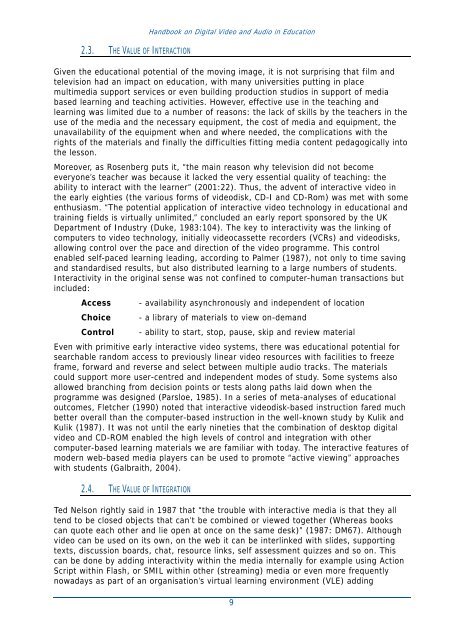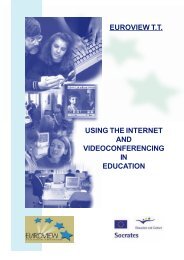Handbook on Digital Video and Audio in Education - ATiT
Handbook on Digital Video and Audio in Education - ATiT
Handbook on Digital Video and Audio in Education - ATiT
You also want an ePaper? Increase the reach of your titles
YUMPU automatically turns print PDFs into web optimized ePapers that Google loves.
2.3. THE VALUE OF INTERACTION<br />
<str<strong>on</strong>g>H<strong>and</strong>book</str<strong>on</strong>g> <strong>on</strong> <strong>Digital</strong> <strong>Video</strong> <strong>and</strong> <strong>Audio</strong> <strong>in</strong> Educati<strong>on</strong><br />
Given the educati<strong>on</strong>al potential of the mov<strong>in</strong>g image, it is not surpris<strong>in</strong>g that film <strong>and</strong><br />
televisi<strong>on</strong> had an impact <strong>on</strong> educati<strong>on</strong>, with many universities putt<strong>in</strong>g <strong>in</strong> place<br />
multimedia support services or even build<strong>in</strong>g producti<strong>on</strong> studios <strong>in</strong> support of media<br />
based learn<strong>in</strong>g <strong>and</strong> teach<strong>in</strong>g activities. However, effective use <strong>in</strong> the teach<strong>in</strong>g <strong>and</strong><br />
learn<strong>in</strong>g was limited due to a number of reas<strong>on</strong>s: the lack of skills by the teachers <strong>in</strong> the<br />
use of the media <strong>and</strong> the necessary equipment, the cost of media <strong>and</strong> equipment, the<br />
unavailability of the equipment when <strong>and</strong> where needed, the complicati<strong>on</strong>s with the<br />
rights of the materials <strong>and</strong> f<strong>in</strong>ally the difficulties fitt<strong>in</strong>g media c<strong>on</strong>tent pedagogically <strong>in</strong>to<br />
the less<strong>on</strong>.<br />
Moreover, as Rosenberg puts it, “the ma<strong>in</strong> reas<strong>on</strong> why televisi<strong>on</strong> did not become<br />
every<strong>on</strong>e’s teacher was because it lacked the very essential quality of teach<strong>in</strong>g: the<br />
ability to <strong>in</strong>teract with the learner” (2001:22). Thus, the advent of <strong>in</strong>teractive video <strong>in</strong><br />
the early eighties (the various forms of videodisk, CD-I <strong>and</strong> CD-Rom) was met with some<br />
enthusiasm. “The potential applicati<strong>on</strong> of <strong>in</strong>teractive video technology <strong>in</strong> educati<strong>on</strong>al <strong>and</strong><br />
tra<strong>in</strong><strong>in</strong>g fields is virtually unlimited,” c<strong>on</strong>cluded an early report sp<strong>on</strong>sored by the UK<br />
Department of Industry (Duke, 1983:104). The key to <strong>in</strong>teractivity was the l<strong>in</strong>k<strong>in</strong>g of<br />
computers to video technology, <strong>in</strong>itially videocassette recorders (VCRs) <strong>and</strong> videodisks,<br />
allow<strong>in</strong>g c<strong>on</strong>trol over the pace <strong>and</strong> directi<strong>on</strong> of the video programme. This c<strong>on</strong>trol<br />
enabled self-paced learn<strong>in</strong>g lead<strong>in</strong>g, accord<strong>in</strong>g to Palmer (1987), not <strong>on</strong>ly to time sav<strong>in</strong>g<br />
<strong>and</strong> st<strong>and</strong>ardised results, but also distributed learn<strong>in</strong>g to a large numbers of students.<br />
Interactivity <strong>in</strong> the orig<strong>in</strong>al sense was not c<strong>on</strong>f<strong>in</strong>ed to computer-human transacti<strong>on</strong>s but<br />
<strong>in</strong>cluded:<br />
Access - availability asynchr<strong>on</strong>ously <strong>and</strong> <strong>in</strong>dependent of locati<strong>on</strong><br />
Choice - a library of materials to view <strong>on</strong>-dem<strong>and</strong><br />
C<strong>on</strong>trol - ability to start, stop, pause, skip <strong>and</strong> review material<br />
Even with primitive early <strong>in</strong>teractive video systems, there was educati<strong>on</strong>al potential for<br />
searchable r<strong>and</strong>om access to previously l<strong>in</strong>ear video resources with facilities to freeze<br />
frame, forward <strong>and</strong> reverse <strong>and</strong> select between multiple audio tracks. The materials<br />
could support more user-centred <strong>and</strong> <strong>in</strong>dependent modes of study. Some systems also<br />
allowed branch<strong>in</strong>g from decisi<strong>on</strong> po<strong>in</strong>ts or tests al<strong>on</strong>g paths laid down when the<br />
programme was designed (Parsloe, 1985). In a series of meta-analyses of educati<strong>on</strong>al<br />
outcomes, Fletcher (1990) noted that <strong>in</strong>teractive videodisk-based <strong>in</strong>structi<strong>on</strong> fared much<br />
better overall than the computer-based <strong>in</strong>structi<strong>on</strong> <strong>in</strong> the well-known study by Kulik <strong>and</strong><br />
Kulik (1987). It was not until the early n<strong>in</strong>eties that the comb<strong>in</strong>ati<strong>on</strong> of desktop digital<br />
video <strong>and</strong> CD-ROM enabled the high levels of c<strong>on</strong>trol <strong>and</strong> <strong>in</strong>tegrati<strong>on</strong> with other<br />
computer-based learn<strong>in</strong>g materials we are familiar with today. The <strong>in</strong>teractive features of<br />
modern web-based media players can be used to promote “active view<strong>in</strong>g” approaches<br />
with students (Galbraith, 2004).<br />
2.4. THE VALUE OF INTEGRATION<br />
Ted Nels<strong>on</strong> rightly said <strong>in</strong> 1987 that “the trouble with <strong>in</strong>teractive media is that they all<br />
tend to be closed objects that can’t be comb<strong>in</strong>ed or viewed together (Whereas books<br />
can quote each other <strong>and</strong> lie open at <strong>on</strong>ce <strong>on</strong> the same desk)” (1987: DM67). Although<br />
video can be used <strong>on</strong> its own, <strong>on</strong> the web it can be <strong>in</strong>terl<strong>in</strong>ked with slides, support<strong>in</strong>g<br />
texts, discussi<strong>on</strong> boards, chat, resource l<strong>in</strong>ks, self assessment quizzes <strong>and</strong> so <strong>on</strong>. This<br />
can be d<strong>on</strong>e by add<strong>in</strong>g <strong>in</strong>teractivity with<strong>in</strong> the media <strong>in</strong>ternally for example us<strong>in</strong>g Acti<strong>on</strong><br />
Script with<strong>in</strong> Flash, or SMIL with<strong>in</strong> other (stream<strong>in</strong>g) media or even more frequently<br />
nowadays as part of an organisati<strong>on</strong>’s virtual learn<strong>in</strong>g envir<strong>on</strong>ment (VLE) add<strong>in</strong>g<br />
9



